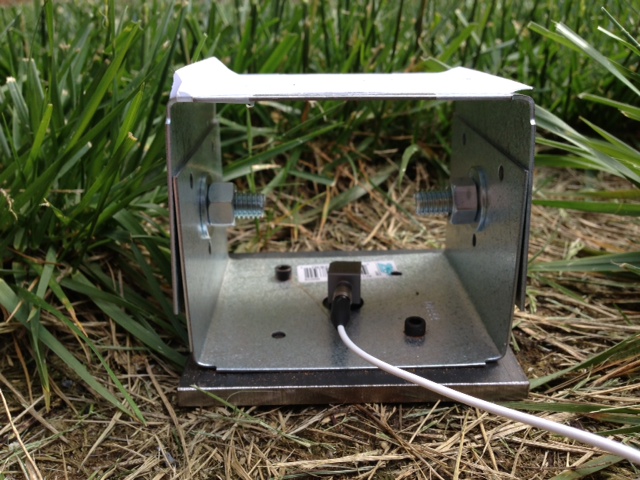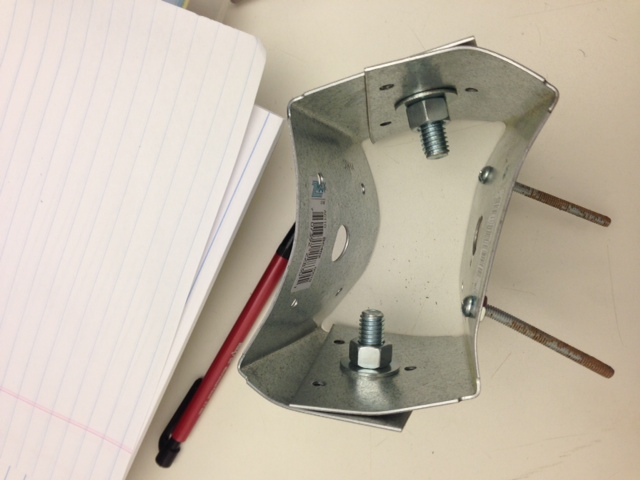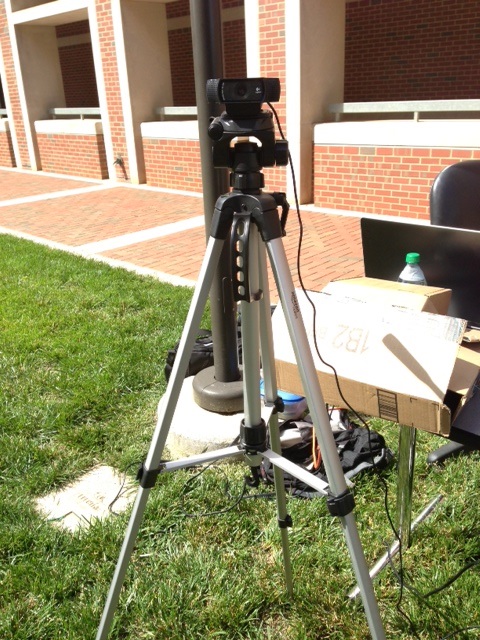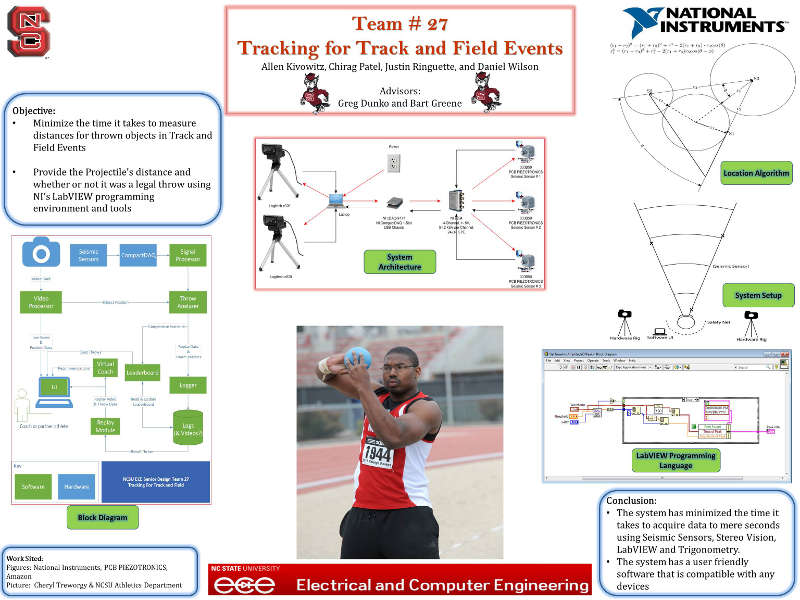From Friday, April 19th (11:00 PM CDT) through Saturday, April 20th (2:00 PM CDT), 2024, ni.com will undergo system upgrades that may result in temporary service interruption.
We appreciate your patience as we improve our online experience.
From Friday, April 19th (11:00 PM CDT) through Saturday, April 20th (2:00 PM CDT), 2024, ni.com will undergo system upgrades that may result in temporary service interruption.
We appreciate your patience as we improve our online experience.
University: North Carolina State University
Team Members (with year of graduation): Allen Kivowitz (2013), Chirag Patel (2013), Justin Ringuette (2013), Daniel Wilson (2013)
Faculty Advisers: Gregory Dunko, Barton Greene
Email Address: ece-senior-design-group-27@googlegroups.com
Submission Language: English
Title: Tracking for Track and Field
Description:
This project developed an automated distance measurement and video recording device for use in Track and Field throwing events, in order to remove the need for the slower manual measurement currently used.
Products
National Instruments
Other
The Challenge
The throwing events of Track and Field - discus, shot put, hammer throw, and javelin - all consist of an athlete throwing a projectile from within a throwing zone out into a designated field. Once the throw is made, the throwing distance is calculated manually with the use of a tape measure or other implement. A trained coach present during the throw can also offer improvements in technique. This system of manual measurement is time-consuming and the need for a trained coach for technique feedback can be mitigated by recording the throw for the athlete’s own review and offering basic technique suggestions based on an automated analysis of the throw.
The objective of this project is to design and implement an integrated hardware and software system which can track a throwing implement and accurately measure its flight path and final distance. The system can be used to replace manual distance measurement, reducing the time between throws both in practice and meet settings. It will also provide basic suggestions to improve throwing technique. Recordings of the throw can be reviewed so the athlete can receive immediate feedback, even if a coach is not available. If a coach is available, the coach can replay past throws and use his or her expertise to refer to specific areas of improvement.
The Solution
This project integrates an accelerometer sensor array that detects the throwing implement’s point of impact with a stereo camera system that records the thrower from two different throwing angles, exceeding the utility of the previous video camera solutions while offering the expansion potential for using 3D algorithms to analyze the thrower’s form and make automated technique suggestions.
All software for this project was developed in the G programming language using National Instrument’s LabVIEW development and runtime environment.
<Explain the benefits using LabVIEW and NI tools.>
LabVIEW development permitted smooth and rapid implementation of software in a modular fashion at the conclusion of the design phase. Its high level dataflow language, G, allowed us to code directly from flowcharts with in most cases only minor deviations in structure. This is a significant improvement over more traditional languages used for this task, such as C++, where there are several disparate ways in which a simple flowchart task can be implemented, and an overhead of boilerplate code such as variable scope management, function prototyping, and especially synchronization logic if the application is parallelized. The end result is that LabVIEW produced quality code that was more easily understood far more quickly, and the simplicity of its interface allowed us to develop in it after only one week of training (Core 1 and Core 2) versus the months normally required for competence in procedural or object-oriented languages.
<Insert image(s) of project with captions.>

The complete system set up indoors. Left: two tripods with cameras. Right: shotput and three accelerometer sensors. Justin Ringuette (project manager) pictured.

A close-up of the accelerometer surrounded by its impact housing, which provides a firm mechanical couple to the ground as well as protecting it from shotput impacts.

An impact test of the accelerometer enclosure. Three separate shotput impacts were performed on this enclosure. Note the change from screw fittings to a metal plate and that the deformation poses no risk of contact with the sensor pictured above.

A single tripod with webcam. The tripod includes three axis levels and several degrees of freedom, allowing the camera to be installed properly on any terrain. It can also telescope vertically to the desired capture height.
<Insert video here.>
A video recording of the drop test, which demonstrates the accelerometer sensitivity. This test used a 12lb collegiate women's/high school men's shotput. Collegiate men's shotputs are 16lb and so would be easier to detect.
<Level of completion (beta, alpha, or fully functional)>
<Time to build>
Project design began in early January of this year and concluded with a system demonstration on April 25th. Total development time is approximately four and a half months.
<Additional revisions that could be made>
The impact triangulation modules need to be completed and integrated, and the distance triangulation algorithm has room for further optimizations, particularly those that leverage frequency spectrum analysis for impact detection. The overall system can also be expanded to function with other throwing events such as discus and hammer.
Attach Poster (30 in. x 38 in.) and LabVIEW Code

Tracking for Track and Field design poster which overviews the project objectives, architecture, setup, the triangulation algorithm, a high level block diagram of the system, and a conclusion of the project at the end of development.
<Include captions for all graphics material. Type your photo or graphic caption underneath each graphic using this 10 pt Times New Roman font. Embed all graphics. Remember—you must provide individual electronic files for each graphic you include in your paper. Place photos in text after first reference—you must include a reference to all graphics in the text. Include screen captures if you use National Instruments software products. Screen captures must have a minimum resolution of 72 dpi at 100 percent. All other graphics must have a minimum resolution of 300 dpi.>
Nominate Your Professor (optional)
<Insert nomination. Does your professor use LabVIEW or other National Instruments technology to make learning difficult concepts engaging, interesting, and fun? If so, nominate him/her as an outstanding educator by telling us who they are, what they teach, and how they make learning a better experience for you.>
Guys - terrific job with the systems design a dn algorithm development for this project. Also, I was very impressed with your commitment to maximize your understanding of the NI tools and LabVIEW development environment!